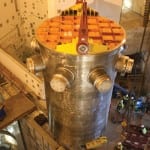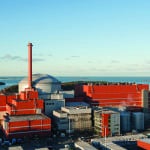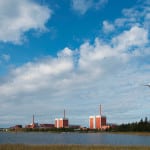More trouble has been reported at one of the four European Pressurized Water Reactor (EPR) units currently under construction.
AREVA announced on April 7 that chemical and mechanical testing conducted on a reactor vessel head and bottom similar to that of the Flamanville EPR (a 1,630-MW unit under construction on the west coast of the Cotentin Peninsula in France) has identified high-carbon concentration in the steel, causing the material’s mechanical toughness to be questioned.
The testing was conducted in late 2014, according to the Autorité de Sûreté Nucléaire (ASN), France’s nuclear regulator. AREVA said it would perform additional testing—expected to begin this month once the ASN approves the testing program—to more accurately determine the areas of concern and the exact mechanical properties of the metal.
The reactor vessel head and bottom are partially spherical forged steel components. Nuclear fuel pellets are contained within rods inside the vessel. Because the vessel forms the second containment barrier, after the rod, its integrity is extremely important for reactor safety.
The Flamanville unit is not the only EPR to have experienced difficulty however. In Finland, Olkiluoto Unit 3 is nearly 10 years behind schedule and vastly over budget. Teollisuuden Voima Oyj (TVO)—owner and operator of the Olkiluoto facility—and the AREVA-Siemens construction consortium have had an arbitration case before the International Chamber of Commerce since December 2008 attempting to resolve responsibility for the cost overruns.
Two EPR units under construction in China are also behind schedule. Taishan Unit 1 was originally expected to come online in December 2013, but the latest reports indicate that it won’t be complete until late this year or early next. Taishan Unit 2 is expected to follow roughly a year later.
Last month AREVA asked the U.S. Nuclear Regulatory Commission to suspend its safety review of the U.S. EPR design until further notice, sending a clear signal that it doesn’t expect construction on a U.S. reactor to begin anytime soon.
To add insult to injury, AREVA has been losing money hand over fist. The company reported a loss of €4.9 billion ($5.6 billion) for 2014, after having lost €500 million in 2013. At least some of the financial difficulty has been attributed to cost overruns at nuclear projects.
In the meantime, work continues on the Flamanville EPR. When the new testing is complete, the ASN said it would “check its correct performance and examine the file to be submitted by AREVA to demonstrate the robustness of the Flamanville EPR reactor vessel.” It noted that the Institute of Radiation Protection and Nuclear Safety, and the Advisory Committee of Experts for Nuclear Pressure Equipment would also be involved in the evaluation.
—Aaron Larson, associate editor (@AaronL_Power, @POWERmagazine)










